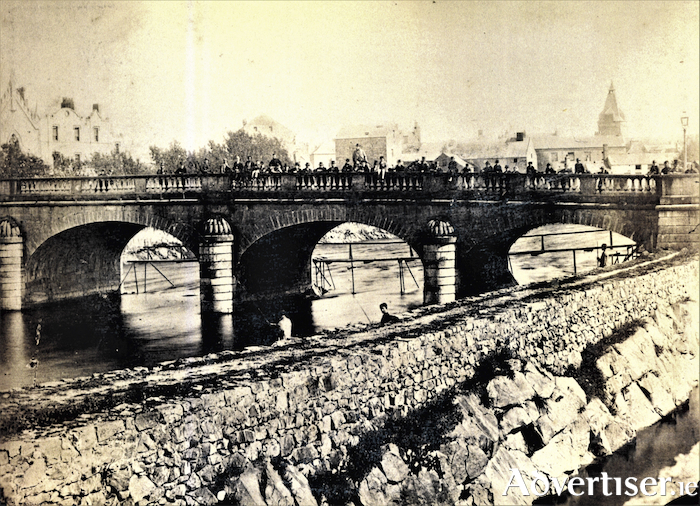The foundation stone for this bridge was laid on June 29, 1818, by William Le Poer Trench and the structure was completed the following year. The original purpose was to connect the new County Courthouse with the County Gaol on Nuns' Island. It is a fine gently humped five-span bridge which was originally known as ‘The New Bridge’ or ‘Gaol Bridge’.
The major public works scheme begun during the Famine which constructed the canal, Steamer’s Quay, and built up the banks on each side of the river, resulted in excavations of the depth of the river which necessitated the underpinning of the piers and abutments of the bridge to an extent of seven feet. This was completed with ashlar masonry of a character which was suitable to that of the bridge.
Just above the bridge was the weir which backed up the water above it to afford power for some dozen mills through the 19th century.
Years ago, roughly between April and July, one could peer over the fast moving water and watch the salmon fight their way upstream to their traditional spawning grounds. The bridge has a high parapet, worn glossy smooth by the coat sleeves of countless thousands of lookers on. There are convenient places to rest one’s feet, so many would lean over to look down. At first, you could not see any fish, then suddenly you saw one, then another, then you realised you were looking at hundreds of them. This remarkable sight became a major tourist attraction.
A description published in The Illustrated Sporting and Dramatic News in October 1879 described the scene wonderfully. “The handsome stone bridge that spans the rushing Corrib, though at all times and seasons a loitering place for the idlers of the sleepy old Citie of the Tribes, is, at ‘Salmon Season’ the grand focus of superabundant lassitude. Young, old and middle aged, the grave and the gay, the jaunty shop clerk and the floss-choked bag weaver, the sleek smug merchant and the Spanish featured ‘Boccach’ or lame beggar, the priest and the parson and the matron and the maid, all and everyone, be their hurry never so great, or their very idleness distressing, pause here to take a peep over the parapet at the glorious fish in the swift clear water beneath, lying thick as pebbles and quite as motionless save now and then when some salmon of business makes a rapid dart above his fellows through the limpid element. It is pleasant to stand among this heterogeneous throng and listen to the speculations concerning the weight of the fish below, or the exulting bold stories of bamboozling the keepers, and the jovial defrauding of the fishery proprietors.”
Sadly, the dredging of the river in the late 1950s put an end to the salmon congregating under the bridge, but anyone who saw them was unlikely to forget the experience.
So we have two images for you this week, the first shows a crowd assembled on the bridge during the ‘salmon season’ and was kindly given to us by the Chetham Library in Manchester. It dates from c1865. The second was taken from the bridge by the local photographer Bertie Simmons, c1900, and was given to us by Paddy Kelly. It shows a good number of salmon waiting their turn to move upriver.
Two weeks ago, in this column we showed you a colour photograph of a young Claddagh lady modelling a cloak. I am afraid we put the wrong name on her, she was, in fact, May Nan Toole, generally known as ‘Main’. Apologies to all concerned.
Finally, a note to tell you that William Henry will be addressing the Renmore History Society at 8pm this evening in the Connacht Hotel on the subject of his excellent new book A River Corrib Guide. All are welcome.

